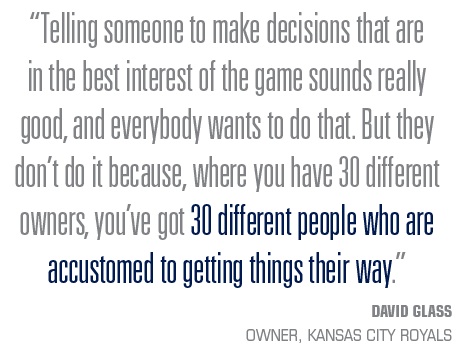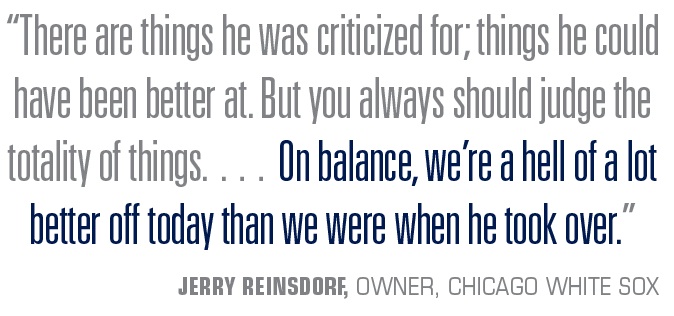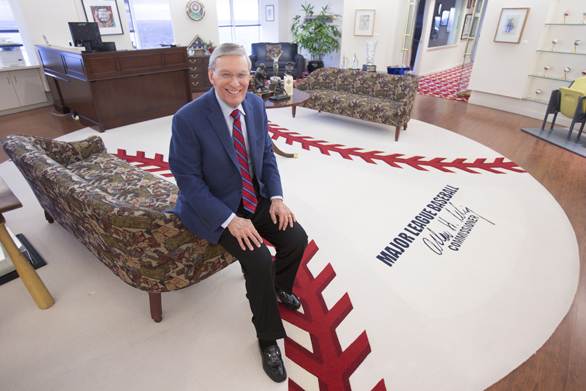 |
Selig poses in the commissioner's office in Milwaukee.
Photo by: Scott Paulus / Milwaukee Business Journal |
Bud Selig strode through the stately lobby of Milwaukee’s historic Pfister Hotel on a Wednesday morning in August, hopeful that he might be on the verge of progress in a sport that moved at the same pace as its grass grew.
For the better part of the year, he had been working on a pet project, the introduction of interleague play in Major League Baseball. While not a new idea, it had been a divisive topic within the sport for decades.
Still, Selig had generated enough momentum to get a joint committee to study the idea. At the summer meeting in his hometown, Selig was to present the committee’s recommendation, a humble schedule of four to six interleague games per club.
“We had it done,” Selig said, recounting the story one afternoon last month in his Milwaukee office, a scant
2 1/2 blocks from the Pfister. “And then the National League guys killed it.”
The year was 1973.
Selig was not yet the commissioner of baseball, or even its acting commissioner. He was in his fourth season as owner of the Milwaukee Brewers.
He realized on that day that while he had figured out much of what it took to run a ballclub, he knew little about how to operate within a league, and particularly within this league, where small clusters of owners could torpedo most any change.
{podcast}
SBJ Podcast:
Staff writers Bill King and Eric Fisher, as well as Executive Editor Abraham Madkour, discuss Bud Selig's 22 years as baseball's statesman.
More than 40 years later, Selig thought back to that meeting, the lesson he learned and the way in which it guided his future in baseball, all the way to and through a 22-year term as commissioner that, while rife with turmoil at the start, will go down as the most transformational of any in the sport’s history.
Though it would take 23 years, Selig got interleague play. More importantly, and astonishingly, he got revenue sharing. He got two wild-card slots in the playoffs, and then two more. He got pooled Internet rights. He improved competitive balance. He achieved labor peace. All while an industry worth about $1 billion grew to approach $9 billion.
“People would say, ‘Bud didn’t do this and Bud didn’t do that,’” Selig said, thinking back to criticism he took for being slow to take action at times. “But that’s not the way you get things done. At the end of my administration, people can analyze all the changes. They may think it took too long. But they don’t understand the politics and they don’t understand the people. So that’s my style.
“I knew my group. I knew how they acted and how they didn’t act and what they did and what they didn’t do.
People could be critical, because it’s easy to be critical when you don’t know what you’re talking about. When you look back now on the 22 years, even I am sort of stunned.
“I mean, wow.”
Learning to lobby
Selig was talking baseball from behind his desk, framed by a view of Lake Michigan 30 stories below, when the discussion landed on interleague play, and that afternoon more than 40 years ago at the Pfister.
After watching his proposal fail spectacularly, Selig went immediately to his baseball mentor, John Fetzer, owner of the Detroit Tigers. Fetzer corralled Red Sox owner Tom Yawkey, and together they explained to Selig what had happened: That a core of NL owners remained intractable, as they had for years, and there was nothing his committee could have done to sway them.
After dinner that night, a still dejected Selig hurried off to County Stadium to check on his club, which was playing
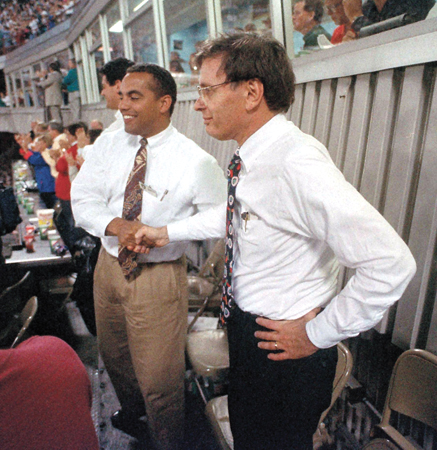 |
Selig watches a Brewers game in 1992, on the same day as being named acting commissioner.
Photo by: AP Images |
the Chicago White Sox. Fetzer asked to join him. Pittsburgh Pirates owner John Galbreath also wanted to go along.
On the ride, Selig listened as if in a lecture hall with two Nobel laureates. Galbreath explained that he, too, favored interleague play, a revelation that surprised Selig, since the vote against it had been unanimous. Galbreath said he didn’t think the proposal was worth dividing the league over.
Similarly, while Commissioner Bowie Kuhn had indicated he favored interleague play, he wasn’t willing to draw from a dwindling account of political capital to force it through.
That night, as he left the ballpark, Selig realized that to have an impact on the game beyond the walls of the Brewers’ offices — and from his first taste of an owners meeting he aspired to do precisely that — he would have to approach issues more like those on a legislator’s agenda than an executive’s to-do list.
Solutions were merely starting points. He needed to corral votes.
“Mr. Fetzer taught me well,” Selig said. “This is not a group you start banging around and try banging things through. Because you wind up getting nothing. Which is what happened for 2 1/2 decades.”
Of course, Selig didn’t give up on interleague play. He simply waited its opponents out. By the time it finally came, MLB had approved an expansion to 30 teams and realigned from four divisions to six, adding two wild cards. It was planning 15 teams in each league, which would have necessitated AL teams playing NL teams.
 |
Selig learned how to play ball with owners, enabling him to nudge along policy changes.
Photo by: Scott Paulus / Milwaukee Business Journal |
The meeting that led to realignment, in September 1993 in Boston, was a brouhaha more like those that Selig had witnessed in his earlier years. Selig was acting commissioner. He had sizable influence, enough, in fact, to lead the removal of his predecessor from office. He was confident he had the votes to pass realignment and the wild card.
When he got to the meeting, he found he was wrong. Six American League owners opposed the plan, which was enough to kill it. Infuriated, Selig gathered the dissidents and tore into them.
“I had to go to the back of the room and change some votes,” is how Selig describes it today.
The proposal eventually passed 27-1, with the sole opposition coming from Texas Rangers managing partner George W. Bush.
Baseball owners and executives tease Selig about his near-obsession with passing matters unanimously. He continues working an issue even after he knows he has enough votes to win, sometimes holding off on a vote until he’s pocketed every last ballot.
His record indicates how well his approach has worked (See story).
During a break between sessions at a recent MLB quarterly meeting, Chicago White Sox owner Jerry Reinsdorf spoke frankly about what he saw as the strengths and weaknesses of Selig as commissioner. The two are close friends, so much so that they speak nearly every day and share lunch on weekends when both are at their winter homes in Phoenix. But they have crossed swords on occasion, most notably on the recent selection of Selig’s successor, Rob Manfred.
“There are things he was criticized for; things he could have been better at,” Reinsdorf said. “But you always should judge the totality of things. … On balance, we’re a hell of a lot better off today than we were when he took over. And that’s how you judge it.”
One-on-one approach
Kansas City Royals owner David Glass sat outside a ballroom at the most recent baseball owners meetings in November, chatting while the occasional well-wisher stopped by to congratulate him on his team’s postseason run.
The hotel on Kansas City’s plaza seemed a fitting spot for Selig’s next-to-last owners meeting, just as the Royals vs. San Francisco Giants matchup a month earlier seemed apropos for his final World Series in office.
 |
Even when he has enough owner votes to pass an issue, Selig lobbies to make it unanimous.
Photo by: Scott Paulus / Milwaukee Business Journal |
When Selig took over as acting commissioner in 1992, the Giants were so badly in need of a new ballpark that they had agreed to leave a top-10 market for the baseball hinterlands of St. Petersburg, Fla.
The Royals were about to become the poster child for the game’s economic disparity, a franchise that had battled the New York Yankees on equal footing through the 1970s and won the World Series in 1985, but would flounder for decades, often with payrolls cut to the bone.
When Selig was together with Glass and Giants CEO Larry Baer in October, he told them he saw the series as “a manifestation of what we set out to do 20-some years ago.”
Glass let out a small chuckle when asked to recall the impressions from his first owners meetings after taking over as interim CEO of the Royals in 1993.
“I thought everyone was crazy,” Glass said, “and that the game had almost insurmountable problems.”
This was what Selig inherited.
To say that MLB was able to overcome those problems because Selig was a great “consensus builder” — the common theme of the recurring Selig narrative — is like saying Rickey Henderson stole 1,406 bases because he was fast or Barry Bonds hit 762 home runs because he was strong. True, but vague and oversimplified.
All of Selig’s predecessors set out to work in baseball’s “best interest,” to use the phrase long associated with the commissioner’s office. And yet one after the next fell by the wayside, stymied and then spit out.
“Telling someone to make decisions that are in the best interest of the game sounds really good, and everybody wants to do that,” Glass said. “But they don’t do it because, where you have 30 different owners, you’ve got 30 different people who are accustomed to getting things their way. And persuading them isn’t easy.
“I’ve seen Bud get extremely tough, and actually threaten and rant and rave and scream. And I’ve seen him be very persuasive in a calm and logical way. He just works at it until he gets people to understand it’s going to happen.
And if it’s going to happen we might as well all get behind it and make it happen the right way.”
Manfred, the longtime MLB executive who will succeed Selig as commissioner next week, met Selig while an associate at a law firm in 1988. Manfred was prepping witnesses as MLB prepared its defense in a collusion case.
Selig was the head of the Player Relations Committee, which dealt with the union. Before long, Manfred moved off the litigation and on to MLB’s CBA negotiations.
Manfred said he can count the days he has not spoken to Selig since 1991 “on two hands.”
He explains the way Selig works with other owners as you might describe a governor working with state legislators, or the leader of the Senate working with committee chairs.
“Bud is a one-on-one politician,” Manfred said. “He has a way of forming relationships with people and delivering to people things that they need at important points of time that creates a tremendous reservoir of loyalty that he is able to draw down on when he needs it. I think some people think it’s like swap deals. That is not true. He never swaps. Instead, it’s relationship oriented.
“Rob Manfred needs x, y or z. He takes care of it. You go along. Rob Manfred needs x, y or z. He takes care of it.
All of a sudden it comes to a point where he needs a vote, and Rob Manfred has this feeling that this guy was always there when I needed him; I gotta be with him on this.”
Prodded to describe how Selig does what he does, Reinsdorf starts ticking off some of his most striking accomplishments, then counts the years — and sometimes decades — that each took to achieve.
“A lot of things happened under Selig because he would be talking to people over such a long period of time, it was
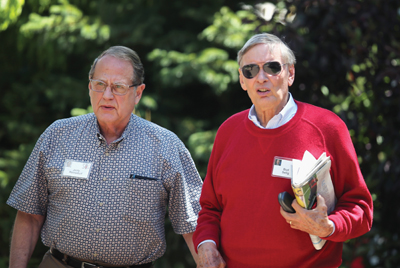 |
Chicago White Sox owner Jerry Reinsdorf (left) speaks with the commissioner nearly every day.
Photo by: Getty Images |
almost like osmosis,” Reinsdorf said. “He’s great at conditioning the market. And he has a long view. You talk to someone for four or five years about something and, eventually, they just assume it’s going to happen. I may not agree with it. But I see it’s going to happen, so what am I going to do? I try to make it work.”
It starts, many say, with communication. Selig spends the bulk of each day on the phone, speaking with owners and, more importantly, listening to them. He is on-call, always, for all of them.
“Bud is the best politician I’ve seen in the role of commissioner,” said Paul Godfrey, the former Canadian politician who was president and CEO of the Toronto Blue Jays from 2000 to 2008. “I watched him. He knows where everybody is and if he thinks you’re going to go offside before a meeting, he’ll call you. If you went offside during a meeting, he’ll pull you out and say, ‘What did you do?’
“I could call Bud on Christmas Eve and he’d phone you back. … He would work the phones. That’s why his tenure lasted so long: Because he knew how to do favors for people. He knew if you really needed him, if you leaned on him, he’d say, ‘Look, OK, I’m going to do for you.’ He didn’t ask for anything in return, but he knew he made you feel that you were the one, and you owed him one.”
Tom Werner witnessed Selig’s work from the contrasting perspectives, first as managing partner of the San Diego Padres, at the time a low-revenue club, and now as co-owner of the high-revenue Boston Red Sox.
“He may not have had an agenda that everybody agreed with on even one point,” Werner said. “But his passion, his intellect, and his likability allowed people to vote for him, even when it wasn’t in their best interest. It’s remarkable, for example, that he gets teams like the Yankees and Red Sox to vote for increased revenue sharing when it might not be in our own particular self-interest. We do that because of Bud’s ability to convince, cajole, charm — all those things.”
Manfred points to a meeting in Fort Lauderdale, Fla., in 1994, when after years of bickering over revenue sharing, Selig emerged with a 28-0 vote in favor of it.
It didn’t stick, because owners also tied in a salary cap proposal at which the players union predictably balked. But, within ownership, it was a watershed moment because, for the first time, owners agreed upon compromises that would lead to economic reform.
“To this day, I don’t know how it happened,” Manfred said. “But when George Steinbrenner stood up and said, ‘Yes,’ he was looking directly at Bud Selig. Some conversation there got George to do it. And George later told me the only reason he did it was because of Bud.”
The brilliance, several owners said, was in tying revenue sharing to the larger labor deal. The owners who opposed revenue sharing stood to lose the most from a work stoppage. Each time increased sharing has come up, it has been in the context of a labor deal.
Selig had no such lever when he got the Yankees to drop their opposition to MLB Advanced Media, which would pool the resources of all the clubs to create a single Internet company. At the start, the Yankees were sure they could generate larger profits on their own, just as they had generated larger TV rights deals on their own.
“He convinced them that they’d be better off with a smaller piece of a bigger pie,” Reinsdorf said. “And that’s when they came around. I think there are very few people that you can get to vote against what they perceive to be in their own selfish best interest. But they don’t always perceive it right. So you try to get them to understand that what they think is in their best interest is not in their best interest. That’s what Selig did with the Yankees.”
MLBAM was a tall order because it required each club to not only invest $1 million a year each for four years and cede its Internet rights, but also to take marching orders on something that seemed inherently local from a central entity based in New York.
“You have to remember, BAM was disruptive,” said MLBAM CEO Bob Bowman, who not only survived in that position but will ascend to the broader position of MLB president for business and media under Manfred. “And while we like to think we did it politely, we disrupted. So there were issues with partners. Issues between clubs. And he had the courage, and the talent, to see it through. When someone called to say BAM did this wrong — and we probably did, frankly — he would say, ‘I’ll fix that, but BAM is staying.’”
Selig dealt with the MLBAM board in the same way he dealt with the broader group of owners on contentious issues over the years. He worked the phone, doggedly and tirelessly, often into the nights and over weekends.
“He’s a big believer that if you’re talking you’re not fighting,” Bowman said. “If you’re talking there is always room for compromise. … He spent as much time talking with people who were against him as those who were with him. He is the best floor whip any legislature has ever seen.”
The first dealing Atlanta Braves CEO Terry McGuirk had with Selig was when he was CEO of Turner Broadcasting in the mid-’90s. Then known as the Superstation teams, the Braves and the Tribune-owned Chicago Cubs were at odds with MLB over rights fees, and the way money moved between the parent companies and the clubs.
Selig turned the tenor of the discussion between MLB and Turner from a prosecution to a negotiation, determining what the Braves’ rights would have been worth in an open market and assessing TBS a fee based on that.
McGuirk figures he had about a dozen conversations about the matter with MLB, all of them with Selig.
“I did a lot of deals with [former NBA Commissioner] David Stern when I was at Turner,” McGuirk said. “David would know your business better than you knew your business when you sat down to negotiate with him. In a way, Bud didn’t absolutely know your business, but he knew you better. He is the ultimate people person. He has an ability to find how to put people together with common thought. If you were an outlier, you felt like it, and you wanted to get in line with the system.”
Selig gets ribbed for holding off on votes until he knows his side will not only win, but pitch a shutout. To St. Louis Cardinals owner Bill DeWitt Jr., that’s emblematic of the cultural shift that Selig fostered among a once-fractured ownership group.
“If he doesn’t feel like anyone is going to get there, he’ll delay the vote until he convinces those who aren’t in agreement that it’s the right thing,” DeWitt said. “It enables everyone in the industry to feel like we’re all on board. Whatever that issue happens to be, however we got there, we’re all together.
“That’s one of the more remarkable things about his tenure. You don’t have the [voting] blocks anymore; the antagonism of one group of clubs against another. It’s a real credit to his leadership and his sensitivity to everybody’s needs.”
John McHale Jr. was a teen when he first met Selig, who then was a car dealer who palled around with Milwaukee Braves players and executives. McHale’s father, John, was the Braves’ general manager.
Now MLB’s executive vice president of administration, one of McHale’s roles over the last decade has been as Selig’s fixer, dispatched to diagnose problems for clubs that were struggling financially. “Johnny, here’s a problem,” Selig would tell him. “Go fix it.” With a background as a senior team executive, McHale has great appreciation for the way Selig works his constituents.
“It is the skill of a consummate politician,” McHale said. “He had a way of developing fabulous, strong, candid relationships. Nobody in a league can lose all the time. You can’t always have your way. But you can’t never have your way, either. And so there has to be a variety of initiatives and programs that are good for everybody. And sometimes they benefit one class of clubs a little bit more and sometimes they benefit another class of clubs a little bit more. But eventually, everybody has to feel like their interests are represented and their well-being is at the forefront.”
Bringing baseball back
The hostess at the Pfister coffee shop didn’t even spin around when asked whether former Sen. Herb Kohl of Wisconsin had arrived for a midmorning meeting.
“If he were here, we’d know it,” she said, grabbing a couple of menus and heading to a table near the center of the room. “He’ll want to sit over here.”
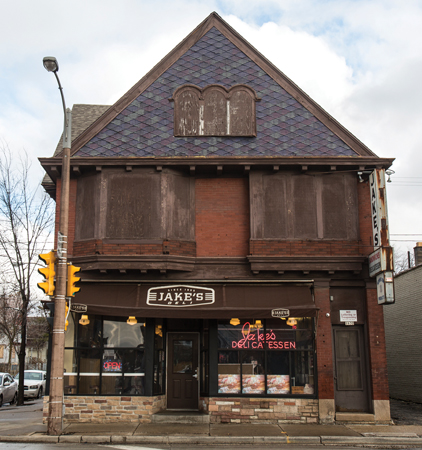 |
Selig often meets friends and baseball insiders at Jake's, a Milwaukee deli he co-owns.
Photo by: Scott Paulus / Milwaukee Business Journal |
Kohl served three terms in the U.S. Senate, retiring in 2012. He’s known Selig since first grade. They grew up on the same street in Milwaukee. When they didn’t walk to school, their fathers took turns driving them. They went to high school together and roomed together at Wisconsin, where they served successive terms as president of their fraternity.
When Selig successfully relocated the Seattle Pilots, Kohl was an investor. When the NBA’s Milwaukee Bucks started talking about moving in the 1980s, Kohl bought the team to make sure it stayed.
Over the years, Kohl and Selig have remained close, meeting for weekend breakfasts at a local deli in which Selig now owns a large stake, talking sports and politics. Selig is 80 and about to retire as commissioner, but plans a busy second act that will include teaching at his alma mater and writing a memoir.
Kohl likes to tease his old friend, telling anyone who will listen an old story about how Selig brought in a ringer to pitch for the peewee league championship when they were in sixth grade. “Almost 70 years later, he’s the commissioner of baseball, protecting the integrity of the game,” Kohl said setting up the punch line of the old story. “That shows you how screwed up life can be.”
At the mention of Kohl, Selig nodded and smiled. “He knows me well,” Selig said. Then he paused as if remembering something. “I hope he didn’t tell you that same rotten [sandlot baseball] story, did he?” Selig asked.
“Not that he’s a poor loser. But do you know how long ago that is?”
While the two old friends do their share of ribbing, their respective histories — both former team owners; Kohl in politics; Selig fascinated by politics — have provided fodder for hour upon hour of topical conversation.
“He’s done a wonderful job as the shepherd of the sport for many, many years,” Kohl said. “He came to the job in a way that made it easier because he was a team owner. I think that’s as good as, or better than, any other preparation.”
Selig takes pleasure in the fact that so many say this now, that the very thing that many held against him at the start is now held up as a bedrock of his achievements.
“You remember all the stories about how an owner shouldn’t be commissioner?” Selig asked rhetorically. “Well, it turned out to be the best training ground in the world. There wasn’t a subject that came up that I hadn’t put up with with the Brewers.”
If there was a first indication of the persistence that would mark Selig’s career in baseball, it came as he clawed for 5 1/2 years to right what he perceived to be a great wrong, the loss of a major league club in Milwaukee (See story).
From the time in 1964 that the Braves announced their intention to move to Atlanta, Selig was banging to get a team back, lining up investors, working the lobby at owners meetings, trying to convince anyone who would listen that they had made a mistake.
The turning point came when Milwaukee hosted a Monday night exhibition game between the White Sox and Minnesota Twins in July of 1967.
Two days before the game, they had sold about 25,000 tickets. About 5 o’clock, Selig’s office phone rang. A staffer manning the ticket office was calling to report a crisis.
“We’re running out of tickets,” the flustered man said.
“You think that’s a problem?” Selig asked.
“Well, all we’ve got left is a few in the bleachers,” he said.
Outside, the lines were deepening.
Selig called a former Associated Press writer he knew who was working with the commissioner’s office. They were in Cooperstown for the Hall of Fame induction, planning to head from there to Milwaukee for the exhibition. The AL president, Joe Cronin, also was coming.
Selig asked if, since it was an exhibition, they could rope off areas on the field to create more seats. “Go ahead,” his friend said. “Just don’t ask anybody else.”
When the game started, there were 51,144 paid in the ballpark, with 6,500 of them on the field. On a wall in Selig’s office hangs a photo from that night, showing a sign declaring “We Deserve Major League Baseball” in the bleachers in left field.
“The place was mobbed,” Selig said. “It really was a wonderful night.”
On the strength of that showing, Selig convinced the White Sox to play eight games in Milwaukee the following season. A year later, before the start of the 1970 season, the ownership group he led bought the Seattle Pilots out of bankruptcy, returning baseball to Milwaukee.
It was after he heard the details of that lengthy quest that Manfred first began to understand Selig. When he met him, he saw the Brewers owner as a “one-issue guy,” a “zealot” dedicated to bringing economic reform to the game.
Manfred thought back to what Selig put into the team, then considered what it must have been like for him a decade later, when financial pressures made it ever more difficult for teams in smaller markets such as Milwaukee to compete.
“I saw his passion for reforming the economics as the natural progression from bringing baseball back to Milwaukee,” Manfred said. “They lose the team. It breaks his heart. He gets this team to Milwaukee. He gets going with the team … He’s probably thinking this is his life’s work. And then he sees, ‘Oh my God, if I don’t fix the system, the same damned thing is going to happen again and they’re going to move away again.’”
So it was that, a few years into ownership, Selig began working toward change. Kuhn, commissioner at the time, put Selig in charge of spreading the gospel of revenue sharing, sending him from team to team to try to convince owners of its merits.
That’s how Selig became fast, though seemingly unlikely, friends with Steinbrenner, the Yankees owner.
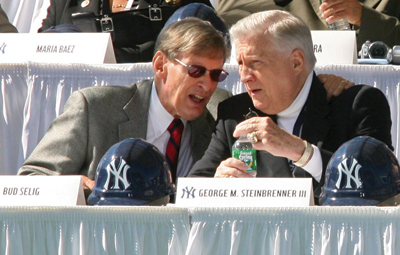 |
Selig's ability to build consensus was never more evident than in his dealings with New York Yankees owner George Steinbrenner.
Photo by: Getty Images |
Steinbrenner was a staunch opponent of revenue sharing, largely because he had the most to lose. But the two owners spent a lot of time talking and became close.
“George and I had this strange relationship,” Selig said, pulling out a card Steinbrenner sent him in 2006, which he saved and came across recently while sifting through his papers. “We never agreed on a single thing. But yet, we were friends.”
Their differences tested that friendship on occasion, never more so than in 1997, when the Yankees joined Adidas in suing MLB in an attempt to secure their own $95 million apparel deal. It came to a head during a meeting in Milwaukee, when both Selig and Steinbrenner were fuming. When they went into the hall after it was over, Steinbrenner tried to explain that he “had to” join in the lawsuit because his attorneys advised him to.
“That’s fine, George,” Selig told him. “We’ll figure this all out. But this is not good for baseball. And if it ain’t good for baseball, it ain’t good for you.”
Steinbrenner left for the airport in a huff. About an hour later, he called Selig.
“I care just as much about the game as you do,” Steinbrenner shouted into the phone.
“I know you do, George,” Selig said calmly. “I believe that.”
It took another year, but they resolved the matter. MLB removed Steinbrenner from its executive council. The Yankees dropped the lawsuit. The council reinstated Steinbrenner.
Though Selig didn’t immediately think of it that way, the exchange with Steinbrenner that day would provide a blueprint for their dealings for the next decade.
Steinbrenner did not mind going along with Selig, so long as he felt his friend appreciated the historic place of the Yankees franchise and paid homage to it.
“When you’ve been an owner, you understand owners,” Selig said. “You have to remember that, after all, they run the franchise. I know when I owned the Milwaukee club, nobody knew the Milwaukee Brewers like I did. I watched some of my predecessors. And there was very little contact with too many of the owners. You get to a meeting and — wow. I learned a lot of lessons. Political lessons.
“Make no mistake, the commissioner’s job is a political job.”
Passing on the lessons learned
Selig never has been shy about discussing the prickly nature of the commissioner’s role with the senior executives at MLB, and particularly with Manfred, who in his role as labor negotiator had to be kept apprised of pressure points among the broader group of owners.
In recent months, as it became clear that Manfred would be his successor, their conversations — about 10 a day, Selig estimates — shifted from observations about how the current commissioner dealt with matters to advice on how the next commissioner might.
“He has been very emphatic with me about a number of issues,” Manfred said. “One would be that this is a political undertaking. That votes matter. Votes need to be taken at the right time. Votes need to be taken after the appropriate groundwork has been laid.”
There may be no better place to look for the key to someone’s success than in the advice they give to their successor.
Much has been made of the theater that developed around Manfred’s selection as Selig’s successor. When word leaked that Reinsdorf supported Werner rather than Manfred, and that he had marshaled other owners around his favored candidate, it was seen by some as disloyal.
But, really, wasn’t it as it should be? One last stand for Bud Selig. One last vote to count.
He said he never lobbied for Manfred, but he didn’t have to. Every owner in the room knew his preference. When they went into session to elect the next commissioner, Selig knew how it would turn out. He may not have been lobbying, but he had been listening. And counting.
Manfred was not elected on the first ballot, falling three votes short of the required 23. But he got there soon after.
Selig’s choice won, with the final motion coming from the defeated candidate’s Red Sox partner, John Henry, seconded by Reinsdorf.
The vote was unanimous.
Bud Selig by the numbers, since 1992
■ 52,517: Number of games presided over (give or take a few).
■ 20: New ballparks built.
■ $10.54 billion: Total cost to build those ballparks.
■ 9: Clubs that shared a stadium with an NFL team in 1992.
■ 1: Club that shares a stadium with an NFL team now (Oakland A’s).
■ $42.5 million: Average annual value of ESPN’s rights fee signed in 1994, the first such media rights deal signed under Selig’s watch. The network’s current deal calls for an average payment of $700 million per season through 2021.
■ 31%: Increase in total attendance in 2014 compared to 1992. Last season’s total regular-season attendance was 73.7 million.
■ 4: Countries outside the U.S. and Canada that played host to regular-season games (Mexico, Japan, Puerto Rico and Australia).
■ 3: Number of times Selig announced his retirement.
■ 5: Number of team ownership groups whose tenure matches or exceeds Selig’s tenure as commissioner: Chicago White Sox and Philadelphia Phillies (since 1981), New York Mets (1986), Seattle Mariners and Detroit Tigers (1992)
Source: SportsBusiness Journal research



